Sony Giga Juke NAS-SC55PKE Multi-Room Wireless Audio System Review
Sony Giga Juke NAS-SC55PKE Multi-Room Wireless Audio System
Is Sony's all-in-one multi-room wireless audio system the one to top them all? Andy finds out.
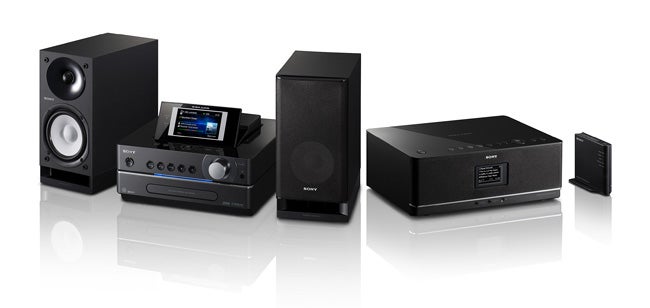
Verdict
Key Specifications
- Review Price: £559.00
If multi-room audio sounds like a cool idea to you, you’d be right. It is cool: very darn cool. It isn’t, however, cheap. For instance, you can get the (article:Sonos-BU150-Wireless-Digital-Music-System Sonos BU150) bundle for £699. but you’re still going to have to buy some speakers for one room and have an existing stereo system in the other. Meanwhile, the (article:Logitech-Squeezebox-Duet-Network-Music-System Logitech Squeezebox Duet) will set you back £280 before you even start to think about the equipment you’ll need to go with it. These, then, are best suited to discerning technophiles/audiophiles and on the more extreme end of the spectrum one could get a custom install, but this is even less of a reality for normal folk than the Sonos’ and Squeezeboxes of this world.
Help is at hand, though, in the shape of all-in-one systems from likes of Philips and today’s contender, Sony. We’re looking at the Sony Giga Juke NAS-SC55PKE Multi-Room package and though not strictly an all-in-one – unlike the (article:Philips-Streamium-WACS7500-Music-System Philips Streamium WACS7500) its speakers are separate – it does include everything you need for a multi-room setup.
Indeed, if its £559 asking price may still sound like a lot of money, when you consider you are getting absolutely everything you need to enjoy music in more than one room, a fully featured stereo hi-fi with amplifier and speakers, plus what is effectively an 80GB NAS box, the value is clear for anyone to see.
Perhaps it is best we start with exactly what you get in the box, since there is lot stuff in there. At the centre of it all is the Giga Juke Music Server that houses the 80GB HDD (63GB Free), the integrated stereo amplifier and the accompanying speakers. This set can be bought separately as the Giga Juke NAS-S55HDE and would set you back around £400.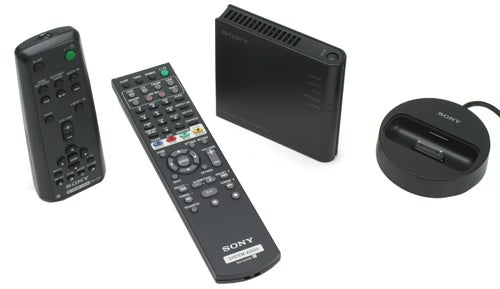
Naturally enough it comes with all the usual accessories such as a remote control (batteries included), antennas for the integrated FM, AM and DAB radio tuners, speaker ccables as well as speaker pads. In addition there’s a Digital Media Port iPod dock that plugs into the back, a USB Wireless Adapter and extender cable to enable wireless networking. It’s a shame this isn’t integrated, as it is on the (article:Philips-Streamium-WACS7500-Music-System Philips Streamium WACS7500), but it’s likely a symptom of the unit being sold separately as a non-wireless system as well.
In this package the Music Server is joined by the Giga Juke Wireless Player NAS-C5E. Like the Music Server it can be purchased separately, this time for around the £200 mark, to add extra rooms to your setup. You also get a remote control with batteries supplied and unlike the Music Server the wireless element is thankfully integrated.
Sitting between the Music Server and Wireless Player and allowing for additional Wireless Players to be connected is the Giga Juke Wireless Station. Like the Music Server (with USB adapter) and Wireless Player it supports 802.11b/g Wi-Fi and as usual the wireless security standards up to WPA2. Regrettably there’s no MiMo or 802.11n support, so you’re somewhat limited by range – a theoretical maximum of 38 metres indoors compared to 70 metres on Draft-N. Neither do you benefit from the mesh network system used by Sonos, which makes each wireless unit into a repeater to boost range. 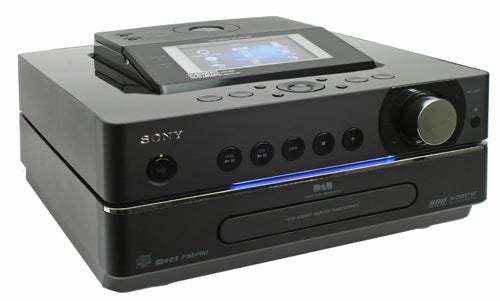
It does, however, feature a handy one-touch security and setup button and Ethernet ports on the back for connecting other wired devices to your media network. All the devices are DLNA compliant so will work seamlessly with other DLNA equipment, including some, but certainly not all, TVs, NAS boxes, PVRs and laptops – check the DLNA website for more info.
Having heaved all these items out of the box setup was remarkably straightforward. In fact, having expected at least a few gremlins, it took less than half an hour to get things up and running properly. We liked the fact that the speaker cables feature easy clip-on plugs at the amplifier end, which saved a lot of back aching fiddling about. We also liked the fact that the Music Server power supply is integrated, though both the Wireless Station and Player feature inline power supplies. 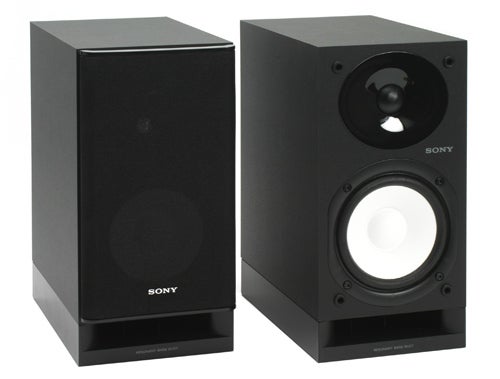
As you would reasonably expect there’s a Quick Setup Guide included in the box and it made the process very clear. Once each of the separate units was connected up properly the Music Server and Wireless Player instantly recognised each other: job done. In this respect, then, Sony has got the end user experience pretty much spot-on and we can’t envisage even a relative novice having too many problems provided they follow the instructions correctly.
Taking a look around the Music Server shows that connectivity isn’t prodigious, though for most needs it should prove more than adequate. Alongside the two speaker outputs there’s a stereo input made up of two RCA/phono jacks and this is followed by the proprietary Digital Media Port (DMPORT) for the provided iPod dock and other accessories – Sony also sells a Walkman compatible version for the usual extortionate price. Pedants might lament the lack of optical or coaxial digital connections but given the amplifier in the Giga Juke is restricted to stereo processing it’s a less pressing issue.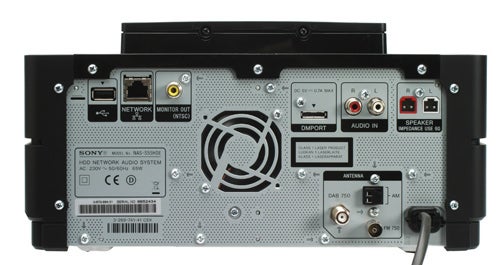
Below these connections are the antenna inputs for FM, AM and DAB radio. It’s great to see a full selection of radio services (Internet radio is also supported); though the cacophony of different antennas is something we could definitely do without!
Staying at the back for the moment, there are three further connections: a USB port, an Ethernet port and a Composite video output. Ethernet can be used for wired connection to the Wireless Station (if that’s not too great an oxymoron) and there’s a cable for this included, while the USB port can be used for connecting the Wireless Adapter, portable hard drive or other media players whose contents can be copied to the hard disk. You’ll probably need that video output, too – we’ll explain why in a moment.
Fascinating though the back of the Music Server is, it’s about time we get to the business end of things. You’ll immediately notice there are a few connections here, with headphone and line-in 3.5mm jacks and another USB port snugly tucked behind a sliding door at the top. More eye-catching, though, is the 4.3in tilt-able colour display. 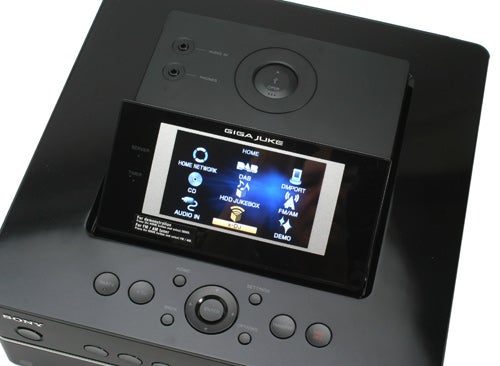
That it’s tilt-able is rather useful – it certainly helps when you’re further away and using the remote. Yet, Sony has clearly missed a trick here because, unlike Sonos, Logitech and even Philips, the remote for the Giga Juke music server doesn’t feature any kind of display. So, though the tilt-able screen certainly helps, it isn’t anywhere near as intuitive as a screen on the remote would be and from a few metres or so you’ll be missing such a feature, since the display quickly becomes difficult to read – its viewing angles aren’t all that impressive, either.
This is where that composite output comes in handy, because it allows you to output the display to a secondary screen – most likely a TV. This goes some way to relieving the lack of a screen on the remote and would be useful during a party, but switching inputs on the TV is hardly the most practical solution imaginable for everyday use.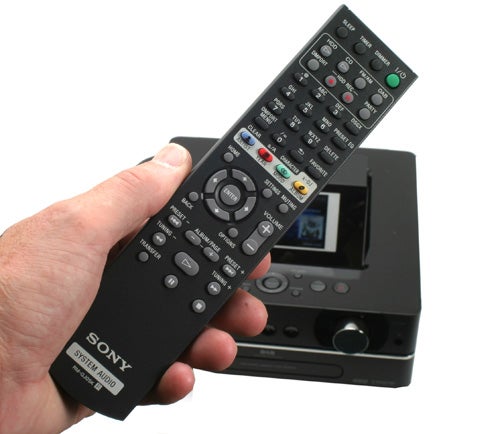
Indeed, notwithstanding the lack of a screen, the Music Server remote is underwhelming in other respects as well. First, it just looks and feels unutterably cheap. Were this a £50 DVD player one might excuse this, but when you’re paying over £500 for a relatively high-end piece of hi-fi equipment one expects a lot more. Secondly, just as it looks like something belonging to a £50 DVD player, the layout seems just as hopeless. Where a little space and order is needed you’re greeted with a mish-mash of function buttons with little coherence or focal point. In time you’ll doubtless get used to it, but it makes using an already complicated device that much harder.
Happily, a lot more thought has gone into the design of the Music Server. Aesthetically it certainly looks the part. There’s a big and friendly volume knob and the button layout on the base unit, unlike the remote, is intelligent and intuitive. Just above the disc drive tray is a rather funky looking blue glow and the tray itself is discreetly integrated into the front. There’s also an incision running across the middle that, deliberately or otherwise, gives the impression of a separates system. It may seem like cheap trick, but visually it works rather well.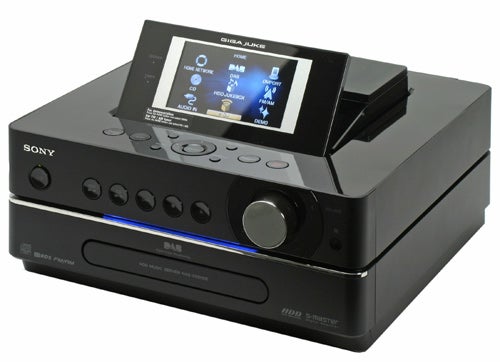
Overall it’s a very attractive but also understated design and though not as eye-catching as the previously mentioned Philips Streamium WACS7500, the base unit has its own sense of class and style and won’t look out of place in your living room.
Compared to the Music Server, the Wireless Player is a rather ordinary looking beast. On the front it has a small 2.5in white on black dot-matrix display. It does the job and is generally perfectly legible, though it could do with being a tad bigger. Below the display and some chrome trim are line-in and headphone jacks while at the back there’s a power input and a USB-B port, though quite what that’s for remains a mystery – there’s no mention of it in the manual. It would have been nice to have a DMPort on there too, but if you do want to connect an MP3 player the line-in will suffice.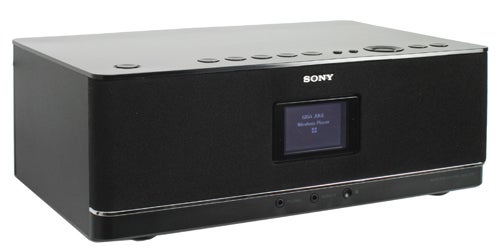
Up top there’s a similar assortment of function buttons to the Music Server and again they’re intelligently organised. Thankfully, the remote for the Wireless Player, if a little bulky, is far more palatable. It helps that there’s a lot less going on, but the buttons it has are evenly distributed and even the plastic used make it feel considerably better in the hand.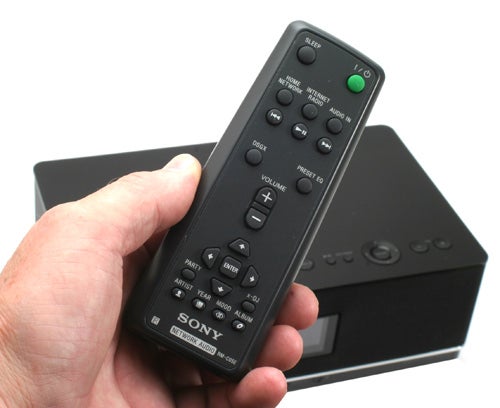
Just like the setup process, using the Wireless Player is blissfully simple. Upon connection to the Music Server you can instantly begin browsing music housed on there, sorted by the usual Artist, Album and Genre denominations. You can also listen to Internet Radio stations through the Live365 service. In addition you can stream music from PCs and compliant NAS boxes connected to the network, as well as listen to music from any device connected to the line-in jack.
There are five preset equalizer modes: Flat, Rock, Pop, Jazz, Classical and Dance. There’s also what Sony calls DSGX (Dynamic Sound Generator Xtra) which, as the name suggests, is the usual artificial processing that boosts bass and “dynamics” and this feature is also found in the Music Server.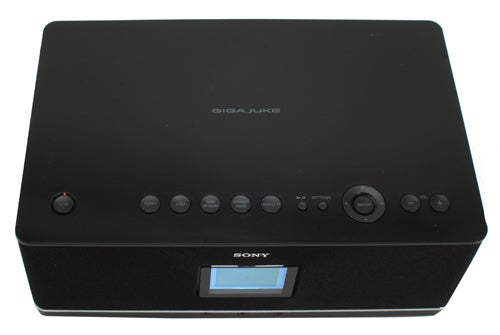
What’s the result? Though no powerhouse, the Wireless Player produces a predominantly pleasant sound given the right source material. It has a nice sense of clarity and tonality for a small unit, though unsurprisingly the sound is quite narrow. Low-level bass, however, is more or less absent save for a dull thud, and subsequently hip-hop and dance tracks lack a little drive. We also found some distortion creeping in, especially when listening to rockier tunes at higher volumes. This shouldn’t be a problem in most scenarios, but it will struggle to fill out larger rooms.
For getting music onto the Giga Juke you’ve got several options. You can import it, either from a PC/NAS Box connected to the network or from a USB hard drive. You can also export in the other direction for back-up purposes or, in the case of an MP3 player, for playback on the move. All these options are relatively straightforward and if you’d rather not store all your music on the Giga Juke you could stream it as well.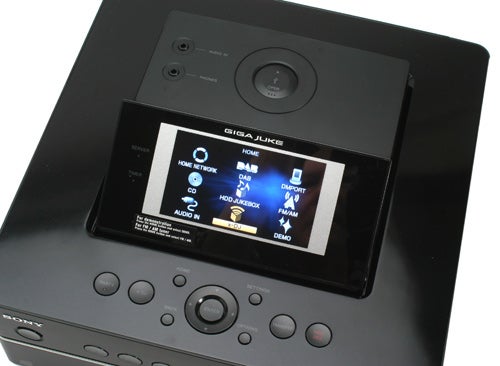
What’s great about the Giga Juke system, however, and what sets it apart from the boutique offerings of Sonos and Logitech, is you can rip CD’s directly to the internal hard drive. This makes it a great way for people less technically minded to digitise their CD collections, though the scarcity of codec options will put off more discerning users since the only choice you have is up to 256Kb/s MP3 or uncompressed Linear PCM.
Indeed, playback options are just as limited with only MP3, PCM, WMA and ATRAC supported. That means no AAC, no Flac, no OGG and absolutely no support for any of the commonly used DRM standards. As much as we dislike DRM to include no support, since it essentially rules out anyone with extensive collections of copy protected music, seems a little short sighted.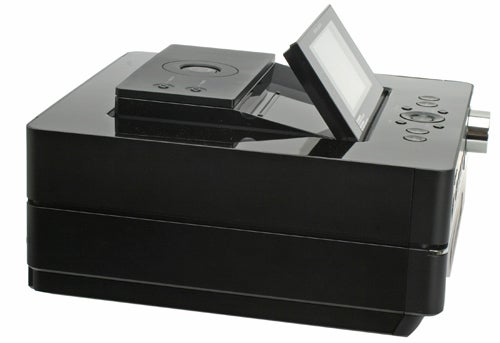
CD ripping, then, is clearly the focus so it’s just as well recording is a relatively straightforward process. Track information is downloaded from Gracenote and upon hitting the ‘HDD Record’ button you’re prompted to select the tracks you want (all are selected by default) and when recording for the first time, the desired format and bit rate if using MP3. This then becomes the default in future recordings, though it can of course be changed at a later date.
Recording speed is far superior to that of the Streamium WACS7500, which is limited to 4x speed whereas the Giga Juke reaches 16x. Recording at 256KB/s MP3 it took four minutes and 43 seconds to copy a 49 minute album. You can also listen to a CD while recording though it will lengthen the recording time; a 65 minute album took 11 minutes using the same settings with simultaneous playback.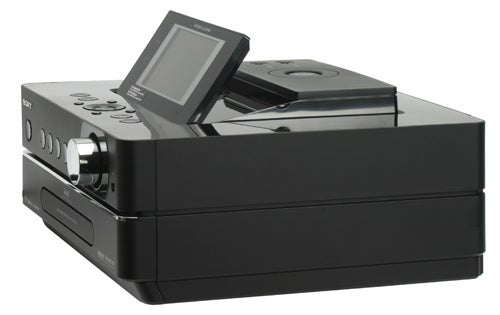
As for sound quality, we went away largely pleased. As with the Wireless Player there’s a nice sense of balance and since the speakers here are separate, the sound produced has a wider and more immersive soundstage. You also get warmer and more convincing bass tones thanks to inclusion of separate woofers and tweeters and front ported speakers. We would add, though, that deeper tones lacked a little definition and had a tendency to reverberate on some tracks. Overall, though not for audiophiles, the audible performance is good enough to please most ears.
So, by now you’ve got everything setup. You’ve ripped your CDs, imported your music collection and arranged everything just so: time for a party? Great though listening to any music you like around the house is, the ability to listen to same track wherever you are is even cooler and this is where the ‘Party Mode’ comes in.
It couldn’t be simpler to use, either. Simply activate the ‘Party Mode’ on the Music Server, select the music you want to play, and all the Wireless Players connected will immediately begin to play: simple as that. It’s a shame that you can only control playback from the host device, but this doesn’t tarnish what is otherwise a brilliant and well executed system.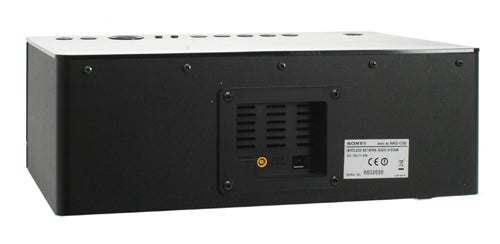
This isn’t the Giga Juke’s only party trick, however. Another key mode is x-DJ and it’s rather interesting. Ostensibly it’s an automatic playlist system but it’s a lot more advanced than anything you might find in a media player, since it actually analyses your music and then categorises it according to Feel, Style and also ‘Scenes’ – including filters for workout music for walking or running. Other filters include ‘Fine Day’ and ‘Rainy Day’ in the ‘Feel’ category and ‘Extreme’ and ‘Acoustic’ in the ‘Style’ category and there are many more.
For the most part it works very well. During playback you can use the remote, both on the Music Server and the Wireless Player, to request tracks from the same artist, of a similar mood or from the same year and album. Occasionally we found tracks that didn’t seem to fit their categories, such as a rather raucous Queens of the Stone Age track in the ‘Vocal’ playlist, but largely track selections were true to their description.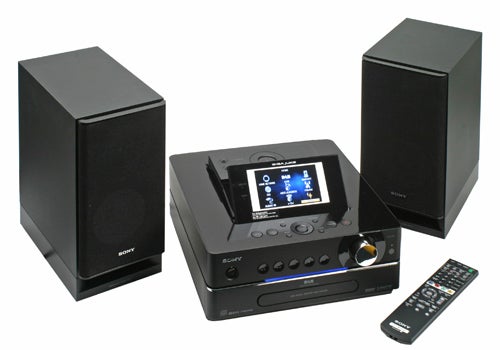
It’s a shame, though, that x-DJ has one semi-fatal flaw. Before x-DJ can work properly tracks must be scanned and it takes a long time; 18 minutes for a 65 minute album to be precise. So, if you’re planning to archive a large CD or MP3 collection and use x-DJ, you’ll need to set aside a lot of time to do it!
This and a few other niggles, like the poor quality remote and limited codec support, take a little shine off the Giga Juke Multi-Room package. Yet it also gets a lot of things right. It’s easy to setup and use and it offers a great and comprehensive mix of features and functionality; besting the competition from Philips in most departments. Most importantly, though, short of purchasing additional Wireless Players, it’s a complete system and this in itself is very attractive.
Verdict
A shortage of codec support and one or two issues preclude the Sony Giga Juke NAS-SC55PKE from a complete recommendation and will put off those looking for an open and flexible system. If you can accept these limitations, however, it offers a complete solution for digitising your CD collection and enjoying music anywhere in the home.
Trusted Score
Score in detail
-
Value 9
-
Features 9
-
Usability 8
-
Design 8

